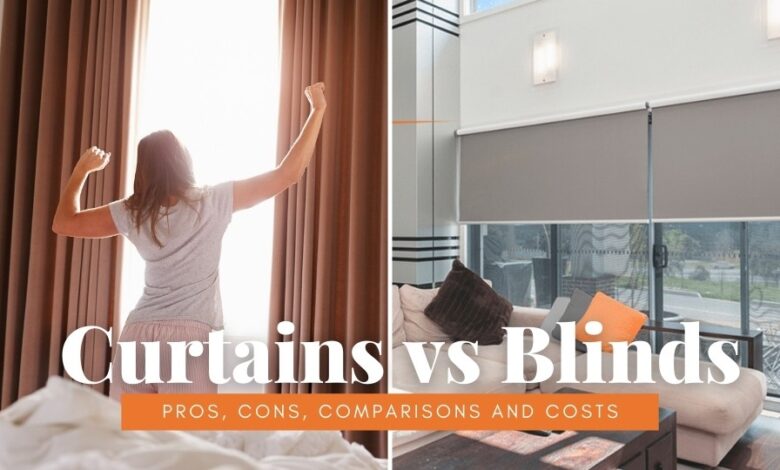Window Blinds vs. Curtains: Which is the Better Choice for Your Home Decor?

When it comes to choosing window treatments, the two most popular options are window blinds and curtains. Both have their advantages, and it can be difficult to decide which is the better choice for your home decor. In this article, we will compare and contrast window blinds and curtains, examining their features, benefits, and drawbacks. By the conclusion, you will know which choice is most appropriate for your requirements.
Window Blinds
Window blinds are a form of window treatment that have adjustable horizontal or vertical slats for privacy and light control. They are typically made of materials like wood, vinyl, or aluminum.
Types of Window Blinds
There are various kinds of window blinds, such as:
Venetian blinds: Venetian blinds are beautiful and elegant, perfect for any room in the house. They come in different colors, shapes, and sizes to suit every need.
Vertical blinds: Vertical blinds provide an ideal solution for the window area in your home. You can easily control the amount of light that is allowed into your room by adjusting the slats of the blind.
Roller blinds: Roller blinds are a great way to add a bit of style to your home. They can be used in any room in your home, and they can also be used to cover windows that are not in use.
Roman blinds: Roman blinds are an important part of any home or office, and can make your room feel bigger or smaller depending on the size you choose.
Cellular blinds: These blinds have a honeycomb-like structure that provides insulation and energy efficiency.
Benefits of Window Blinds
Using window blinds have a number of advantages, including:
Light control: Window blinds can be adjusted to control the amount of light that enters a room.
Privacy: Window blinds can be adjusted to provide privacy.
Energy efficiency: Some types of window blinds, such as cellular blinds, provide insulation and can help reduce energy costs.
Versatility: Window blinds are a flexible option for any decor because they are available in many different styles and materials.
Curtains
Curtains are a type of window treatment that are made of fabric and can be opened and closed using a rod or track. They come in a variety of styles and materials, ranging from sheer to blackout, and can be used to enhance the aesthetic appeal of a room.
Types of Curtains
There are several types of curtains, including:
Sheer curtains: These are lightweight and translucent, allowing light to enter the room while still providing privacy.
Blackout curtains: Blackout curtains are the best way to block out light while still enjoying your view. They are a popular choice among homeowners, as they allow you to maintain your privacy and also enjoy the beautiful view outside.
Grommet curtains: These are hung from a rod using grommets, which are metal rings that are sewn into the fabric.
Tab-top curtains: These are hung from a rod using fabric loops that are sewn onto the top of the curtain.
Benefits of Curtains
There are several benefits of using curtains, including:
Style: Curtains come in a wide variety of styles and materials, making them a versatile option for any decor.
Insulation: Some types of curtains, such as thermal curtains, can help regulate the temperature of a room and reduce energy costs.
Privacy: Curtains can be closed to provide privacy.
Versatility: Curtains can be easily swapped out for a different style or color, making them a versatile option for seasonal decorating.
Comparison
Now that we have examined the features, benefits, of both window blinds and curtains, let’s compare them in terms of cost, style, functionality, maintenance, privacy, and light control.
Cost
When it comes to cost, window blinds and curtains vary depending on the type of material and style. In general, window coverings like blinds and drapes are more expensive, especially if you choose high-end materials like wood or bamboo. Blinds and curtains typically cost different amounts, though this might vary based on the fabric and style.
Style
Both window blinds and curtains come in a variety of styles, but they offer different design options. Window blinds are typically available in neutral colors and textures, and may not offer as many pattern or color options as curtains.
Functionality
When it comes to functionality, window blinds are more effective at controlling light and privacy than curtains. They can be adjusted to let in as much or as little light as you want, and can be tilted to provide privacy while still allowing light to enter the room. Curtains, while they can provide privacy, are not as effective at controlling light.
Maintenance
Both window blinds and curtains require some maintenance, but the level of upkeep varies depending on the type of material and style. Window blinds can be more difficult to clean, as dust and dirt can accumulate in between the slats. Curtains may require more frequent washing, depending on the material, and may also need to be ironed or steamed to remove wrinkles.
Privacy
When it comes to privacy, window blinds are generally more effective than curtains. While curtains may not offer as much privacy when closed, blinds can be adjusted to provide privacy while still allowing light to enter the room.
Light control
Curtains are less effective in regulating light than window shades. They can be adjusted to let in as much or as little light as you want, while curtains may only offer limited control over the amount of light that enters the room.
Conclusion
In conclusion, the choice between window blinds and curtains depends on several factors, including style, functionality, and cost. Window blinds are more effective at controlling light and privacy, but they can also be more expensive and may not offer as many design options as curtains. Curtains are a versatile option that come in a wide variety of styles and materials, but they may require more maintenance and may not be as effective at controlling light and privacy. The ideal option for your home’s décor ultimately depends on your own demands and preferences.





